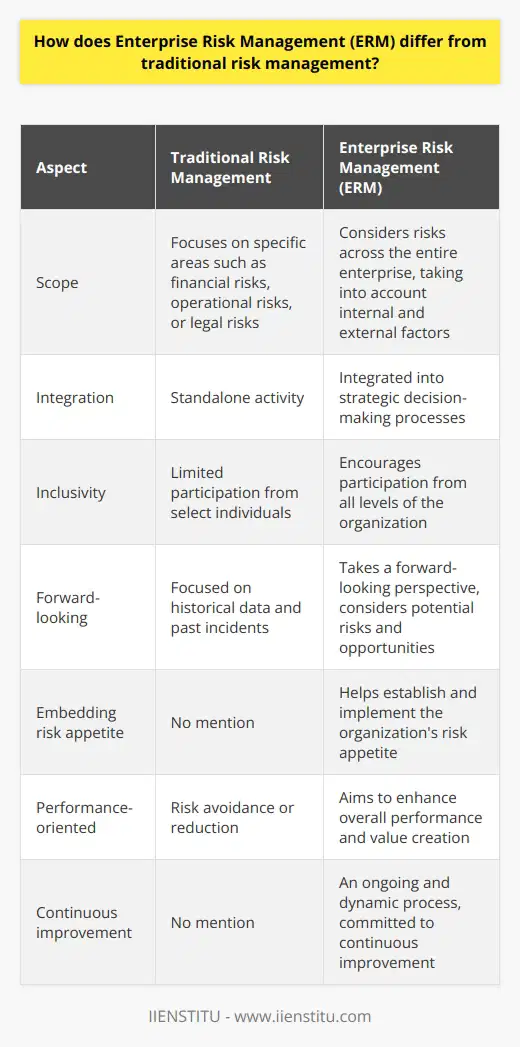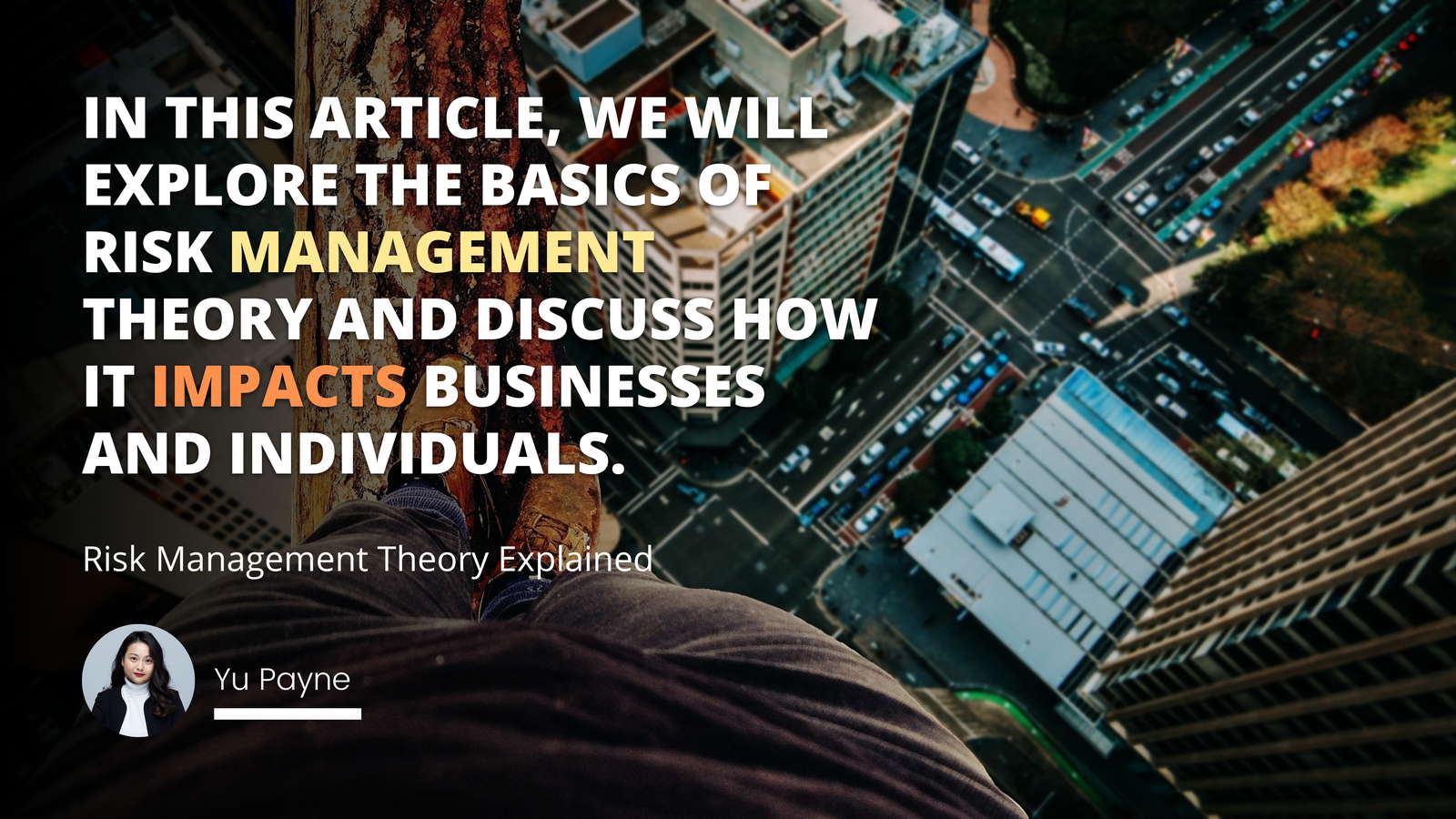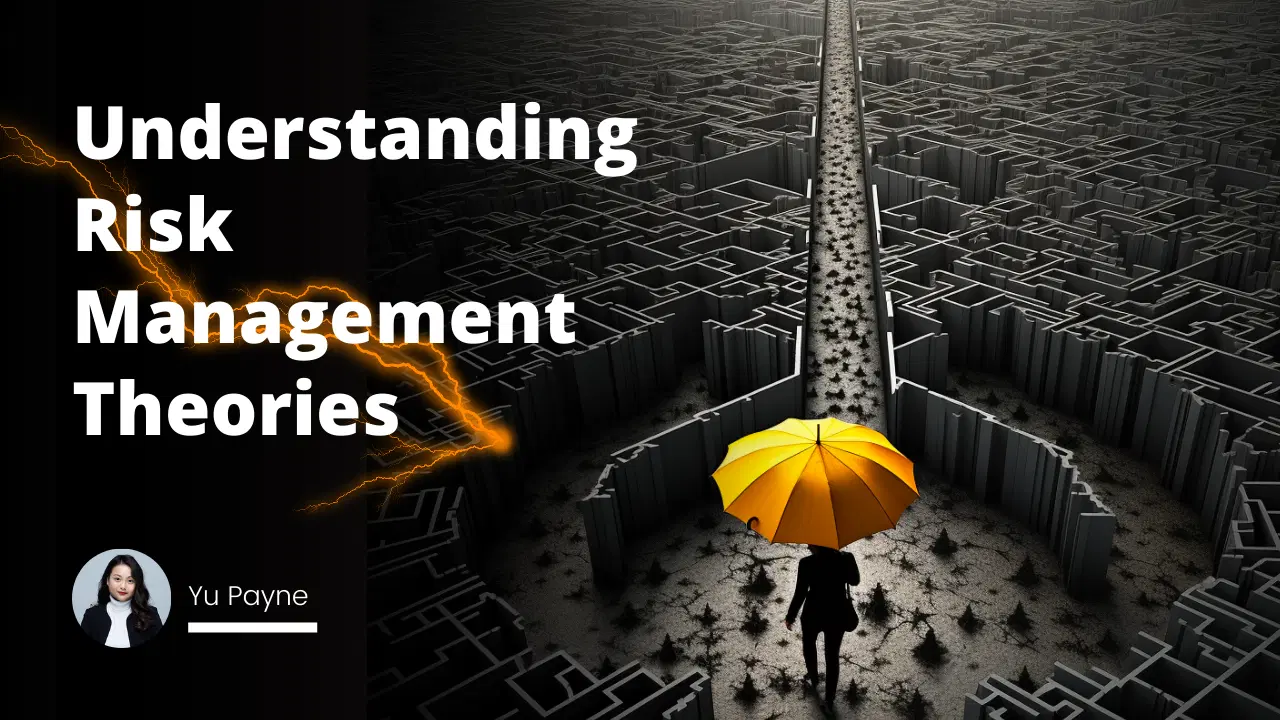
Risk is a constant companion in every facet of our lives, from personal decisions to business strategies and academic pursuits: the uncertainty or the chance of a negative outcome lurking around every choice. Whether deciding on a career path, investing money, or researching a new topic, there’s always the potential for things not to go as planned.
This omnipresence of risk naturally leads to questions:
How can we handle these uncertainties?
Why is it so crucial to address them?
By exploring the risk management domain, we aim to unravel and simplify its profound academic theories and methodologies, making them accessible and relatable to all.
Article index:
Risk Management: What is it?
Risk management is more than just recognizing dangers; it’s a systematic process to pinpoint, evaluate, and prioritize these potential threats. Once these risks are identified, effective strategies are formulated to minimize, monitor, and control unforeseen impacts or capitalize on opportunities.
Imagine planning an outdoor event. There’s always the looming possibility of rain, which could disrupt your plans. In this analogy, risk management acts as the foresight to choose a day with a favorable forecast or have a backup indoor venue—essentially providing a protective layer, much like an umbrella, against the unpredictability of the weather.
Similarly, in life, business, or academics, risk management shields our aspirations, plans, and objectives from the unpredictable storms of life. It ensures that we’re prepared, come what may.
The Importance of Assessing Risk
Risk assessment is the bedrock of effective risk management. At its core, assessing risks involves meticulously evaluating potential threats, gauging the probability of their occurrence, and forecasting their potential impact.
By doing this, organizations can pinpoint their vulnerabilities and weak spots, ensuring they are better prepared and informed. The true essence of risk assessment is not merely about identifying threats but empowering oneself with the knowledge to anticipate and react.

Different Types of Risk Management
Strategic Risk:
Strategic risks are challenges that can divert or derail a company’s long-term vision and objectives. They often stem from internal operational blunders or unforeseen external events.
Examples might include a sudden change in market dynamics, regulatory shifts, or even innovations by competitors. Addressing these risks ensures that an organization remains on its intended strategic path.
Enterprise Risk Management (ERM):
ERM offers a panoramic view of all the risks a company might face. Instead of examining risks in isolation, ERM consolidates them, providing a more comprehensive overview.
The primary goal is to ensure that all operational and strategic risks align with the company’s objectives. This integrated approach enables organizations to respond more efficiently to potential threats, ensuring alignment with their mission and vision.
Financial Risk:
Financial risks revolve around the uncertainties of financial markets and transactions. They relate to fluctuations that can adversely impact a company’s financial health.
This includes but isn’t limited to shifts in interest rates, volatile currency exchange rates, and the unpredictable nature of financial markets. Companies can safeguard their financial stability and ensure consistent growth by understanding and managing these risks.
Operational Risk Assessment Guide For Efficient Business Operations
Failure Modes And Effects Analysis Guide For Risk Management
The Heart of the Matter: Risk Management Theories
Risk Management Theories offer academic structures and principles that shape our comprehension and handling of risks. These theories, stemming from years of research and observations, help predict human behavior in risk-related situations. Here’s a closer look:
Utility Theory:
At its core, it delves into the decision-making process. It posits that individuals base their choices on the perceived satisfaction or “utility” they anticipate from the outcome.
For instance, if a person believes that the potential reward of an investment outweighs the risk, they might be more inclined to invest. This balance between risk and reward, and the value a person assigns to each, determines their choices.
Modern Portfolio Theory (MPT):
Predominantly employed in finance and investments, the Modern Portfolio Theory emphasizes the significance of viewing investments in the context of a portfolio rather than in isolation. It argues that the risk and return of an individual investment are inherently tied to its impact on the total portfolio’s risk and return.
So, rather than focusing on the profitability of a single stock, MPT encourages investors to consider how that stock complements or contrasts with other investments in their portfolio.
By understanding these theories, we gain insights into why individuals and institutions make confident decisions when faced with risk, guiding our risk management and investment strategies.

Risk Mitigation: Reducing the Impact
Upon recognizing the various risks we might face, we must consider the multiple methods we can employ to lessen or manage them effectively. Risk mitigation comes into play here. It offers a range of strategies designed to manage risks effectively.
These involve transferring the risk to another party, for instance, through purchasing insurance, diminishing the potential damage of the risk, or deciding to sidestep the risk entirely by not engaging in certain activities.
Risk Control: Keeping Risks in Check
Risk control is a proactive approach to establishing specific protocols and measures to keep risks within predefined acceptable limits. Think of this as a monitoring system for your risk management initiatives. By consistently checking and adjusting, risk control ensures that the risk strategies are practical and any deviations are quickly addressed.
Crafting a Risk Management Plan
A risk management plan is a detailed blueprint that specifies how an organization identifies, assesses, and responds to risks. The risk management plan outlines the mitigation strategies, beginning with the critical risk identification step.
This document serves as a guiding light, offering clarity and direction and ensuring that organizations can respond promptly and effectively to challenges, providing smoother navigation through the often unpredictable sea of operational hazards.
ERM (Enterprise Risk Management): A Holistic View
While some might think of risks in terms of financial implications alone, Enterprise Risk Management (ERM) takes a much broader perspective. ERM analyzes all potential risks an entity might face, from operational to strategic to financial.
A systematic, structured approach ensures these risks align with the organization’s objectives. Envision ERM as a panoramic view, capturing all potential uncertainties and challenges an entity might confront, providing a well-rounded response strategy.
Risk is everywhere, but we can navigate its challenges with proper risk management. By understanding and leveraging academic theories associated with risk management, we can make better, informed decisions that safeguard our objectives.
Remember this: the goal isn’t to eliminate risk but to manage it effectively. With the proper knowledge, we’re all better equipped to face uncertainties head-on.
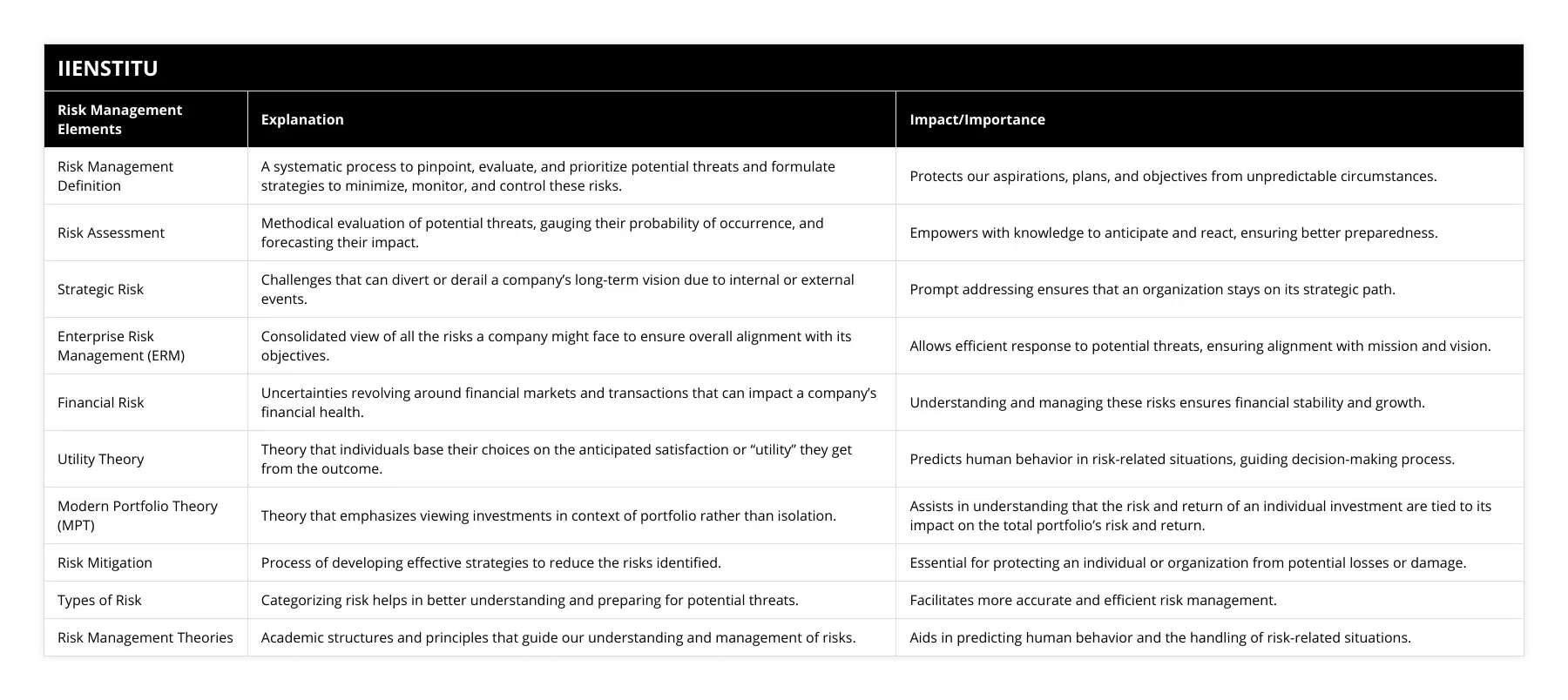
Frequently Asked Questions
What is the primary difference between risk mitigation and risk control?
At a fundamental level, risk mitigation and control are integral components of the risk management process. However, they serve distinct purposes:
Risk Mitigation focuses on strategies to handle the risks that have been identified. This could mean reducing the potential damage of the risk, transferring it to another party (like when buying insurance), or choosing to avoid the risk entirely.
Conversely, risk control is about monitoring and ensuring that the risks remain within predefined acceptable boundaries. It's an ongoing process that checks whether the risk management strategies are practical and adjusts them if necessary.
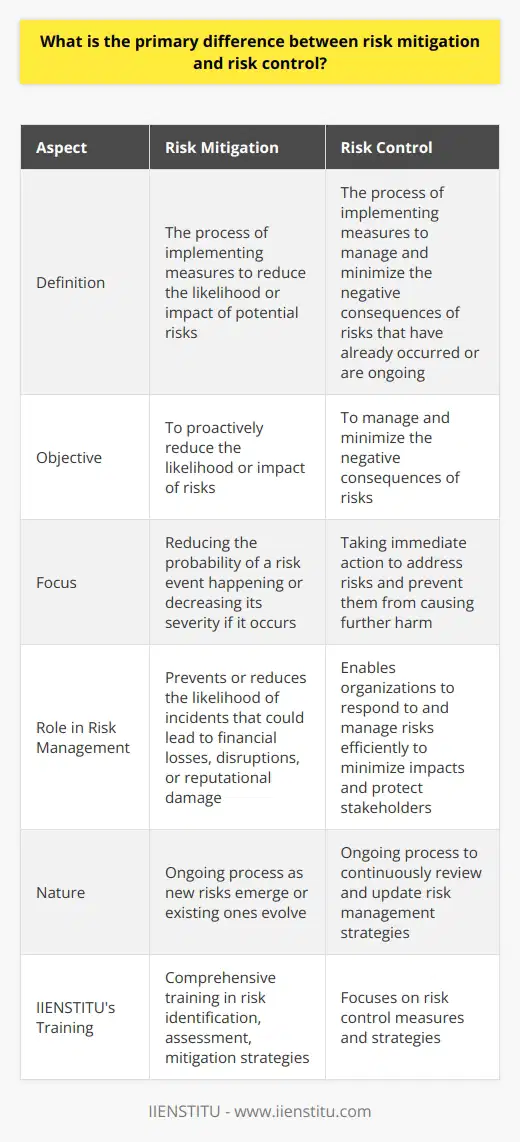
How do risk management theories influence decision-making?
Risk management theories provide the academic frameworks that help shape our understanding of risk and how humans behave in the face of potential threats.
For instance, the Utility Theory suggests that people base decisions on the perceived satisfaction they expect from an outcome.
Another, the Modern Portfolio Theory (MPT), highlights the importance of evaluating investments as part of a more extensive portfolio rather than in isolation.
By grasping these theories, one can gain insights into decision-making processes and enhance risk management strategies.
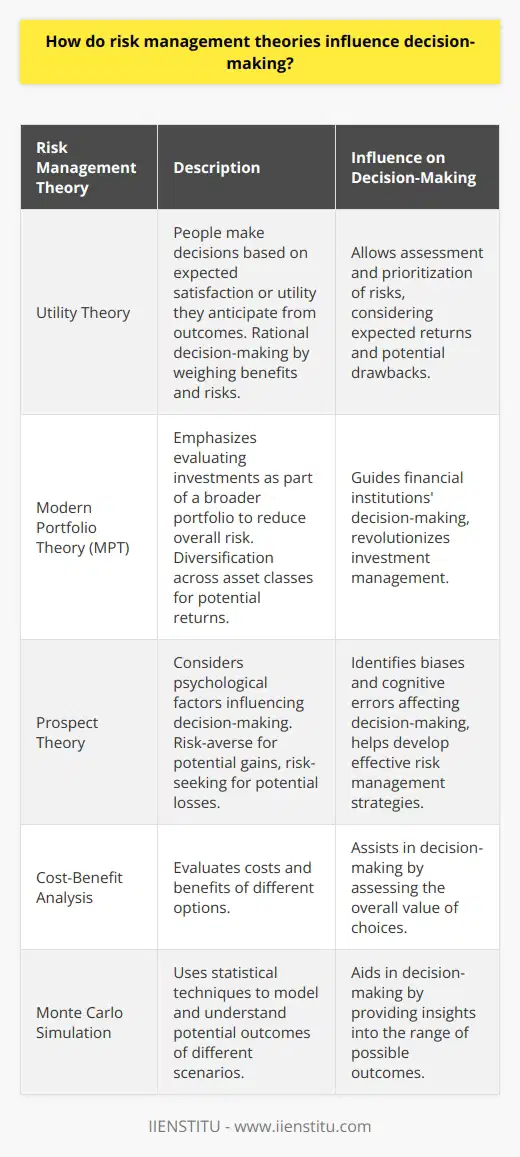
How does Enterprise Risk Management (ERM) differ from traditional risk management?
While traditional risk management often focuses on specific areas (like financial risks), Enterprise Risk Management (ERM) offers a more comprehensive approach:
Holistic Viewpoint: ERM considers risks from all facets of an organization, be it operational, financial, strategic, or any other type.
Alignment with Objectives: ERM ensures that the identified risks and the strategies to manage them align with the organization's overarching goals.
Encourages Organizational Synergy: With ERM, different departments or units work together, ensuring that risks are viewed and managed cohesively, eliminating silos.
